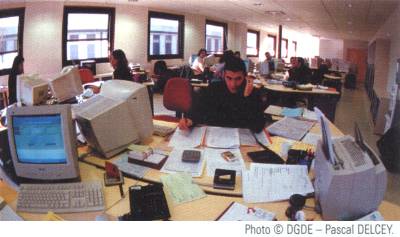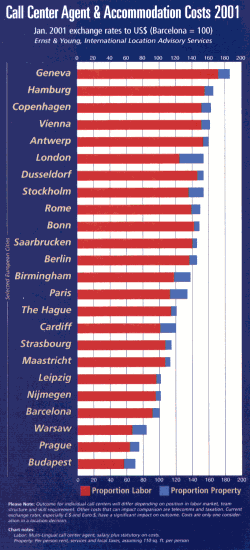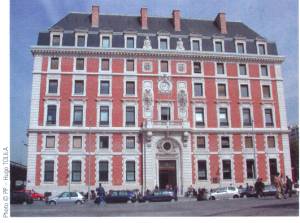
N |
on-European firms seeking to establish a call center in Europe faced relatively few obstacles in the late 1980s and early 1990s. They opened individual centers in whichever countries they felt the need to be in. By today’s standards, the centers were generally low-tech, and the notion of networking multiple centers had yet to catch on in a big way.
The call center industry in Europe today is dramatically different. Technology has redefined the scope of call centers to one beyond mere telephony, and call center strategies are more sophisticated with location playing a more critical role in their effectiveness. The key difference is call centers’ evolution from handling inbound and outbound telephone calls to a broader function known generally as contact management, which can include Internet-based communications with customers outside the sales cycle.
The call center market in Europe and elsewhere is booming, with double-digit growth annually. According to the market research firm Datamonitor, there are presently some 12,600 call centers in Europe, a number estimated to increase to 17,900 by 2003. In addition, Datamonitor predicts that the number of centers dealing with Internet-related issues will grow from 400 in early 2001 to 3,400 during that same time span. For the businesses planning to expand their call center presence, weighing the pros and cons of the traditional strategies for doing so is time well spent.

The Rise of the Pan-European Model
Prior to the mid-1990s, entry into the European call center market involved a country-by-country approach that was limited in application and expensive to implement. These were depressed economic times in Europe. But in the mid-90s, a number of European national telecom companies began to see great potential in call centers. The European economies were lagging far behind the U.S., and unemployment averaged in excess of 10 percent across the continent. Call centers, as a labor-intensive industry, could provide tremendous inward foreign investment funds and a source of employment for the well-educated, but underemployed work force.
The time was right for call center development. It now became feasible to field calls from anywhere in Europe at virtually any location. So the telephone companies, who stood to benefit directly from increased telecoms usage, and economic development agencies joined forces to promote call center development, and in particular, pan-European call centers.
The pan-European model for call centers involves a single center developed to handle customer contacts–inbound, outbound or both–between a company and its customers and prospects. Calls to or from any country in Europe are handled by agents fluent in that language, with a single management team, at a single location.
“In 1994, pan-European was really the only way to address the market,” says Art Coombs, president and CEO of Echopass, a call center information technology (IT) hosting firm. In the late 1990s, Coombs was one of the most high-profile multilingual call center managers in Europe, managing a pan-European technical support center for Sykes Enterprises in Amsterdam. “There was no economy of scale in any other scenario. It didn’t make sense financially, in terms of bandwidth or IT to set up more than one center. Costs in a call center are not linear,” he adds. “In other words, if it costs US$2 million in IT infrastructure to put a 500-seat center together, then your IT costs are $4,000 per seat. But you can’t put a 50-seat center together for $200,000. There are fixed costs that don’t let the equation balance.”
Onno Ponfoort, Area Director of the New York office for the Netherlands Foreign Investment Agency expands on the advantages of the pan-European call center scenario. “In a pan-European model, there are scale and scope advantages, in that more knowledge- and administration-related tasks can be executed at a lower average cost,” Ponfoort explains. “A broader knowledge base can be built and maintained. And a pan-European center allows the entire organization to acquire market knowledge more quickly and easily as opposed to gathering that information piecemeal, center by center.
“In addition,” he adds, “as labor costs (often 65 percent of the total) and real estate costs (10 percent of total costs) differ from country to country, implementing a pan-European approach in a lower-cost environment can save a lot of money.”

One of the biggest problems to the pan-European model is that not every location is well-suited for establishing a pan-European call center. The Netherlands and Ireland were early leaders in the chase for call center investment, and they took different approaches to solving the needs for pan-European centers.
Ellen Oude Lashof, a representative of KPN Royal Dutch Telecom, offers this synopsis of the traits necessary for a successful pan-European call center. “In The Netherlands, all of the factors for success were in place. There is a high quality, multilingual labor market–many Dutch speak two, three or four languages–a very cost-effective and modern telecom infrastructure, flexible labor rules and tax regulations, and a general call center readiness.
Other attributes include high PC penetration, buildings that are prepared for call centers and a high level of service orientation. Additionally,” she adds, “financial incentives in areas with high unemployment help offset initial set-up costs.”
It is important to distinguish between multilingual and pan-European call centers, because not all of the latter are multilingual, points out Mark Hughes, executive consultant, location and real estate advisory services, at Ernst & Young, London. This is particularly true in the case of internal support functions, such as IT. Multilingual centers are more the norm for pan-European facilities. “There is a huge difference in location options and issues between a 50-person requirement with 10 languages, a 300-person requirement with five languages and a 200-person requirement with 170 and 30 of two languages,” Hughes explains.
In Ireland, a slightly different model accounted for early pan-European success. The lowest corporate tax regime in Europe coupled with extremely high unemployment made for a low-cost alternative to locating on the continent. And while the Irish people in general are not necessarily multilingual like the Dutch, decades of emigration created a pool of ex-patriot Irish with multilingual capabilities that were happy for the opportunity to return home.
The biggest advantage to a multilingual, pan-European call center is also the biggest weakness. There is also a finite number of people available with specific language skills and a willingness to work in a call center. Success of the pan-European model has led to a shortage of those people in certain areas with a high concentration of call centers.
Francois Coulomb, strategy and marketing manager with Provence Promotion in the Marseille-Aix-Provence region of France, offers some interesting insights into the challenges of staffing for language. “I spoke to a ‘typical seven-language’ Dutchman,” he relates. “His French was very good, and he was friendly and efficient. But we found out a week later that we had misunderstood each other. Another time, I was speaking to an Italian, who asked me if I could speak English as he would be more comfortable in that language.”
It is difficult to maintain a staff that can provide quality linguistic support for all the languages needed in a pan-European call center. And with the saturation of centers in some areas where the concept has been particularly successful, such as Amsterdam, Dublin and Glasgow, that problem is getting worse.
“Companies are realizing that they have to locate in country they are servicing because of the migration from call center to contact center,” says Craig Matthews, managing director of Teleconcepts Ltd., a Dublin-based call center consultancy. “It is no longer good enough to speak the language. You now must be able to write it-and write it as a business language. Many people who can speak a language cannot write it very well, and it is more difficult still to write in a business context. I believe the days of the large, pan-European call centers are drawing to a close.”
A Region-by-Region Approach
An alternative approach to establishing a pan-European call center has been around since 1993, but it has only lately begun to attract significant attention. That alternative is setting up regional call centers in Europe that support the major languages — English, French and German — and branching out from there.
Dr. Carol Scovotti, Instructor of Marketing at the Univ. of Northern Iowa, was president of Telecom Denmark USA from 1992 to 1996. “In 1993, we were the first to come out and promote a regional concept of call centers,” she notes. “We positioned Denmark as an ideal location for handling calls generated in northern Europe, Scandinavia and Germany in particular. This was done as a way to differentiate our message from that of, say, the Irish and Dutch who were being particularly successful landing pan-European centers.
“The problem many people had at the time was delivering Scandinavian language speakers for a program,” she continues. “We could obviously do that; we had plenty of Danish, Swedish, Norwegian and Finnish speakers, plus German, but we had difficulties coming up with any significant number of agents speaking southern languages, like Spanish, Portuguese or Italian. As such, we developed a promotional approach that focused on showing Denmark as the location to handle northern Europe. I think the idea was ahead of its time.”
Perhaps that time has come, suggests Coombs. “Today, because the markets have grown, people are looking at Europe in terms of cultural and linguistic issues, not IT expense. With the new IT tools available, the primary argument for pan-European centers goes away. Now you can satisfy the cultural issue with fewer bodies, as low as 15 to 20 in each location, without a burdensome IT cost.” The IT infrastructure can be located remotely, reducing its role in the site selection equation. A call center can put the telephony on a remote host allowing development of a call center with only a dedicated line. Agents log onto a Web site, so the only equipment on the desk is a PC with a Web browser.
“The human resources issues are what make the pan-European approach a difficult premise to defend,” says Coombs.
Others agree. Frank Martens, director of the services sector for the Industrial Investment Council (IIC), an economic development agency promoting the former East German states, notes a trend toward decentralization of call centers and toward the establishment of two to four regional sites. He says that these centers often have primary responsibilities for the major languages of English, German or French, and they may include secondary language responsibilities, thus negating the need for a pan-European center.
“Those seeking pan-European solutions are now a minority,” Provence’s Coulomb points out. ” The consolidation era for call centers seems to be over. The demand today is for serving one country first, and later extending the reach to smaller countries.”
The regional approach does offer one additional advantage over that of a single pan-European center, and an important advantage, at that. “The obvious benefit to a regional approach is recruiting native language speakers,” says Scovotti. “But there are additional benefits, such as the ability to flow calls from one center to another in times of emergency. And while that is certainly not what you want to do, at least you can still provide service in a back-up language such as English to customers as part of a disaster recovery program.”
Ponfoort agrees that the trend seems to be growing for the establishment of a “hub and spoke” set-up, whereby one larger center houses the value-added and knowledge-related issues and satellite centers house agents handling local languages. These satellites offer the advantage of being more in tune with local community issues and dialects. But only about one-third of new entrants to the market will abandon the pan-European approach completely, he predicts. They will likely use the pan-European facility as the hub in the hub and spoke structure.
Bob Van Voorhis (email: revv@cfu-cybernet.net) is a free-lance writer based in Cedar Falls, Iowa.
He is one of the founders of TeleProfessional Magazine and TeleProfessional International.
A New Paradigm for Call Center Expansion
One recent development in the call center world that plays in either a regional or pan-European scenario is that of the “Call Center Hotel,” or incubator. In this concept, the developer of the call center is a third party. The facility is developed as a call center, complete with all the telecommunications and computer networking essential for the task. A company wishing to enter the European market can contract for a specific number of seats, for a specific length of time. One can even choose whether or not to supply one’s own agents, or have the “hotel” handle that task. |

